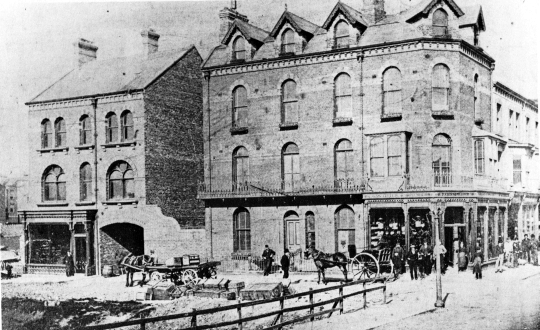ArtsBank Saltburn's major artistic initiative.
Please note that closed in September 2013. The building was then converted into apartments.
ArtsBank was a major artistic initiative, privately funded, and based in Saltburn. Successful local businessman Bryan Goodall (FRSA and chairman of the Hambleton Group)assembled a group of like-minded directors, and formed ArtsBank, with a £600k initial investment. ArtsBank Arts Services Ltd, part of the the Hambleton Group of companies, aimed to present the truth and reality of living, its beauty and its ugliness with a programme designed around the community, and the artists showcased. The Saltburn gallery was also a venue, hosting workshops, live performance and film.
About the Project

ArtsBank began with the acquisition and conversion a substantial Victorian property (the old HSBC bank) in the heart of the beautiful and spectacular resort of Saltburn-by-the-Sea. The whole building was transformed into a five-floor gallery and centre for the arts, with something for everyone.
At its April opening, ArtsBank showcased more than fifty visual artists. They were the cream of an enormous and rich crop of northern talent: painters, photographers, sculptors and craftspeople, from all generations. Some renowned. Some neglected. Some unknown. But all were given the widest exposure.
A boost to North East arts
ArtsBank attempted to make that exposure possible by promoting the work of its artists on an unprecedented scale. Thanks to the established business background, the activities of the Saltburn commercial gallery and shop was matched by access to a huge international online marketing facility, and to a large number of real buyers around the globe, via ArtsBank's own website.
ArtsBank aimed to present the work of all its artists without apology, and with pride, to the broadest community. Affordable prints (manufactured in-house to the highest standards) and original art, all hand crafted in the north east, were available to be delivered to the world, as well as being sold in Saltburn. ArtsBank also toured the country, promoting its artists at shows and fairs.
Central aims for ArtsBank were to involve people from all backgrounds in the cultural life of the region, and to raise the cultural profile of an often-neglected area. ArtsBank hoped to inspire new creative work, across the media, and especially from the young. Outreach activities were available to strengthen ArtsBank's educational and community links. Classes and workshops were also run, developing ArtsBank's association with schools, colleges, community groups and national organisations.
ArtsBank was also a live venue, hosting a wide range of events, talks, etc. Musicians and film-makers had a local platform for their work, with regular performances and screenings at the Saltburn facility. In addition, a free-of-charge mini-cinema at ArtsBank presented short films of local interest on a daily biasis, together with ArtsBank's own artist-profile movies, again made in-house.
Exhibitions were designed to demonstrate engagement with current issues, and with our shared heritage. The work on show at ArtsBank was not exclusively northern, but several exhibitions focused on major creative figures, most of whose work has its roots in the region
29 Milton Street
The 1871 census shows Mr Francis Cunningham, aged 38, ironmonger, from Beelsby, Lincolnshire, living on Milton Street with his wife Margaret and four children. The youngest child, Lucy, aged three, was born in Saltburn so it is likely that the business was established around 1867.

Mr Cunningham's shop (pictured above circa 1875, with Mr Cunningham seen to the left of the image leaning against the iron railings) stood originally where ArtsBank now stands.
The shop to the left of the archway (now part of Saltburn Salerooms and the Victoria Apartments) is also thought to have been Mr Cunningham's.
The origins of banking in Saltburn can be traced back to 1875 when the York City County Bank sent an agent to the town once a week. The Saltburn branch of the bank was opened in February 1876. Mr William Edward Cass was the first manager, having been transferred from the bank's Boroughbridge office on a salary of £150 a year. The original premises of the Saltburn branch are not recorded in the HSBC archives. One source states that it is believed that the branch was located somewhere further along Milton Street. Another source states that the bank was located at 13 Dundas St East which is now the premises occupied by Smith's the butchers.
Mr Cass spent five and a half years at the Saltburn branch before moving to Malton. He was succeeded as manager by Mr Robert Holland.
The York City County Bank purchased the premises of 29 Milton Street in 1888. In 1909 the York City County Bank, along with all its branches, was acquired by the London Joint Stock Bank which in turn was acquired by the Midland Bank in 1918. The HSBC took over the Midland Bank in 1992 and changed the name in 1999. The Saltburn branch of the HSBC was closed on February 8th 2008.








